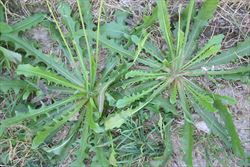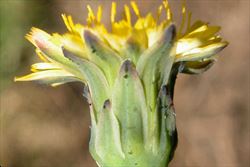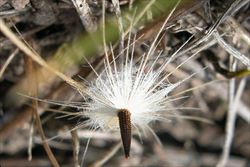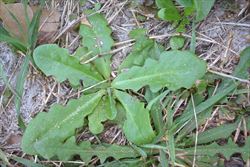Click on images to enlarge

habit (Photo: Sheldon Navie)

habit (Photo: Greg Jordan)

rosettes of leaves (Photo: Sheldon Navie)

close-up of leaves (Photo: Sheldon Navie)

flower-head (Photo: Sheldon Navie)

close-up of flower-head from side-on (Photo: Greg Jordan)

close-up of seed (Photo: Greg Jordan)

young plant (Photo: Sheldon Navie)
Scientific Name
Hypochaeris glabra L.
Synonyms
Hypochoeris glabra L.
Family
Asteraceae (Queensland, New South Wales, the ACT, Victoria, Tasmania, Western Australia and the Northern Territory)Compositae (South Australia)
Common Names
annual flatweed, cat's ear, flat weed, flatweed, glabrous cat's ear, smooth cat's ear, smooth cat's-ear, smooth catsear
Origin
Native to north-western Africa (i.e. Algeria and Morocco) and some parts of Europe (i.e. Denmark, Norway, Sweden, the UK, Germany, Latvia, Ukraine, Greece, Italy, France and Spain).
Naturalised Distribution
A very widely naturalised species that is found throughout the southern, eastern and western parts of the country. It is common and widespread in New South Wales, Victoria, the ACT, Tasmania, many parts of south-eastern South Australia and south-western Western Australia. Relatively common in south-eastern Queensland and occasionally naturalised in central Queensland and the southern parts of the Northern Territory.
Also naturalised on Lord Howe Island and Norfolk Island and in many other parts of the world.
Notes
Smooth catsear (Hypochaeris glabra) is a common weed of gardens, lawns, roadsides, footpaths, parks, pastures, waste areas and disturbed sites in southern Australia. However, it also invades native vegetation, particularly open woodlands and riparian areas. This species is regarded as an environmental weed in Victoria and Western Australia, though its impact in other parts of southern Australia is probably underestimated.
In Victoria, smooth catsear (Hypochaeris glabra) has been recorded in a number of conservation areas (e.g. Brisbane Ranges National Park, Morwell National Park, Kaweka Wildflower Reserve, Phillip Island Nature Park, Rutherglen Nature Conservation Reserve, Terrick Terrick East Nature Conservation Reserve and Yielima Bushland Reserve) and is listed a common weed of sedge-rich woodland, podocarpus heathland and coastal alkaline scrub communities. However, it is only found on a few local environmental weed lists (e.g. in Knox City). This species is also common in several sites in the Mount Alexander Regional Park that are the only known habitat of the endangered southern shepherd's purse (Ballantinia antipoda), and may therefore be a threat to the survival to this rare native species.
Smooth catsear (Hypochaeris glabra ) is probably taken most seriously in Western Australia, where it is listed as a moderately important species in the state's Environmental Weed Strategy. It is becoming common in bushland in the south-western parts of Western Australia and is also present in woodlands in the wheatbelt region. This species is listed as a weed of good condition bushland areas in the City of Armadale and Gosnells and is common in the understorey of shrublands on southern Swan Coastal Plain ironstones (an endangered ecological community).
Smooth catsear (Hypochaeris glabra) is also a common weed of woodlands and disturbed habitats in New South Wales. For example, it is listed as a principal weed species in sandhill pine woodlands, an endangered ecological community in this state, and has also been recorded Basket Swamp National Park on the Northern Tablelands. It is also a weed of threatened natural temperate grassland plant communities in the ACT, of conservation areas (e.g. Mylor Conservation Park, Morialta Conservation Park, Cudlee Creek Conservation Park and Hale Conservation Park) and iron-grass natural temperate grasslands in South Australia, and of grasslands on Norfolk Island.

